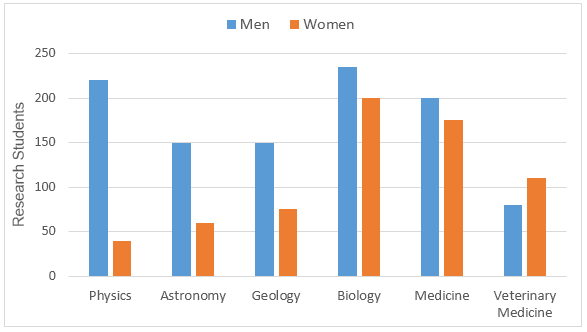Graph Writing # 180 - Research students studying six science-related subjects
- Details
- Last Updated: Wednesday, 26 August 2020 00:00
- Written by IELTS Mentor
- Hits: 62935
IELTS Academic Writing Task 1/ Graph Writing - Bar/Column Graph:
» You are advised to spend about 20 minutes on this task.
The chart below shows the numbers of male and female research students studying six science-related subjects at a UK university in 2009.
Summarise the information by selecting and reporting the main features, and make comparisons where relevant.
» You should write at least 150 words.
Sample Answer 1:
The column graph compares the male and female research students in a UK university in six science-major subjects in the year 2009. As a general trend, biology and medicine were preferred by both sexes while physics and astronomy were picked by male research students in this university.
As is obvious from the given illustration, physics, astronomy and geology were mostly picked by the male research pupils while veterinary medicine as a subject was mostly preferred by females. While more than 200 male took physics, only about 40 female did so and a similar trend could be observed in the case of astronomy and geology. The highest number of students took biology as the number of students in this subject exceeded 400. Medicine was the second preferred subjects by the students of this university with exactly 200 male and about 175 female students. The only subject which got more female students than male was veterinary medicine in which more than 100 female enrolled compared to the just about 90 male students. The number of male research students in this UK university was approximately one thousand while it was about 550 for female.
[Written by - Eva]
Sample Answer 2:
The proportions of research students, both male and female, who were studying in six different science courses at a UK university in 2009 are revealed in the form of bar chart. All in all, the proportions of male research students in Physics, Astronomy and Geology were much higher than the female research students while more female were engaged in Veterinary Medicine than that of males.
Looking at the detail it is clear that the number of male students was always more than the women, except in the research class of Veterinary Medicine. The gap between the number of male and female students is most visible in Physics subject in which there were more than 200 male students against the only 40 female students. Interestingly, the numbers of women students who took Veterinary Medicine was higher than the men, nonetheless. In this faculty, the proportion of men scholars was nearly a hundred, just a couple of tens less than the women. The Highest number of research students were in Biology while the lowest number of that students could be observed in Veterinary Medicine.
In summary, female research students in the UK in 2009 preferred Biology, Medicine and Veterinary Medicine while male research students mostly preferred Biology, Physics, and Medicine.
[Written by - Nur Fadhilah]


As can be seen, among the research subjects, Physics had more than 200 male researchers with a big gap compared to the number of female students, which was below 50. Biology and Medicine students had the most contribution and in both cases, the number of male students had been slightly higher than females. Among these six research subjects, only Veterinary Medicine had more female students with more than 100 researchers whereas this number was below 100 for males. Lastly, Astronomy and Geology students were exactly 150 for males, however, the number of females were not equal in both cases and women tend to focus slightly more in Geology which was around 75 compared to their number of slightly higher than 50 in Astronomy.
Report